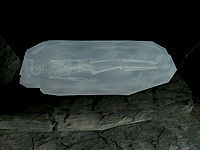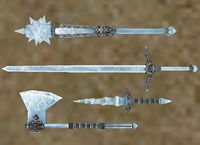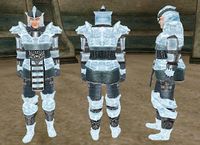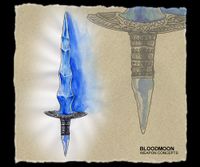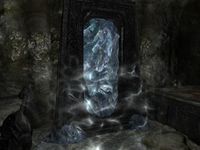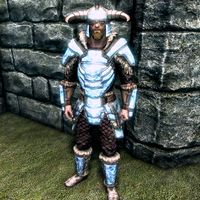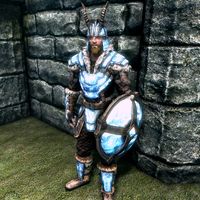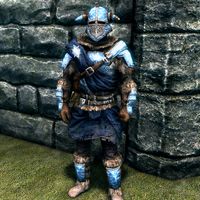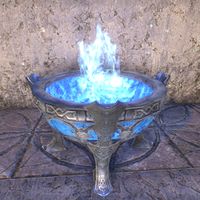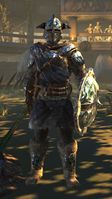Lore:Stalhrim
Stalhrim is a rare form of enchanted ice found only on the island on Solstheim. Throughout history it has served various uses. Originally it was used in the burial rituals of ancient Nords. The deceased would be encased in the material as a form of protection, a privilege that was typically reserved for Nordic individuals.[1][2] It has also served as a crafting material and, with the proper tools and techniques, can be used to create weapons, armor, clothing, and even jewelry.[3][4]
Stalhrim armor (sometimes called ice armor) can be light, medium, or heavy in weight. It is very protective, and is often made with steel or quicksilver.[3][5] Due to its innate properties, frost enchantments placed on items made of stalhrim are more potent.[2] In its raw form, it can be used as an alchemical ingredient that induces paralysis and inflicts frost damage.[3]
Stalhrim is often described as being hard as iron and impossible to break by conventional means. The only known way to mine it is with an ancient Nordic pickaxe, made from superior craftsmanship.[2][6] It has been described as a rigid, blue-white crystalline metal, faceted yet smooth, and unnaturally cold to touch.[7] Working with stalhrim is much like ebony smithing, and can only be performed by a skilled blacksmith.[6]
Role in History[edit]
Legends surrounding its creation date back to the early First Era, when the ancient Nords were at war with the Chimer. Many Nords were killed in battle, and the corpses of those who could not be returned to Skyrim were buried on Solstheim. Due to the threat of grave robbers and necromancy, the Nords worked unknown magic upon the tombs of the fallen warriors to give them protection in death. It is said that energy was drawn from the land itself, and the warriors were encased in tombs of ice, which became known as stalhrim.[8] This practice became tradition among the ancient Nords until it eventually fell out of favor. Conflicting sources instead date the material further back to the late Merethic Era.[1] In ancient times, it was believed to have been used to craft armor for kings that fought in battle.[9]
The Skaal consider Stalhrim to be holy and infused with divine power, and at one point shunned its usage.[8][10][11][12] They also believe the art of forging Stalhrim into weapons and armor is sacred, and certain members of the Skaal were charged as keepers of this ancient tradition.[13] As such, knowledge of stalhrim smithing is very rare and typically known only to the Skaal. However, local Nords and the warriors of Thirsk have also been known to possess such knowledge.[14] The Mace of Aevar Stone-Singer, a prized Skaal artifact, is made from stalhrim.
In the mid-Second Era, Skaal "Frostcaster" shamans made extensive use of Stalhrim by decoratively incorporating the material into their arms and armor. These Frostcasters specialized in Frost Magic in veneration of the All-Maker. King Logrolf of Windhelm was known to have a display of Frostcaster clothing, which was recorded by the famed Imperial Ethnographer Doctor Alfidia Lupus on a visit to his Embassy.[7]
In 3E 427, the East Empire Company discovered a stalhrim tomb in the Raven Rock ebony mine, which had hitherto been unknown to the Empire. They learned of stalhrim smithing from a group of local Nords, but were not as skilled at creating stalhrim equipment and lacked an ancient Nord pickaxe. The company began producing stalhrim items, but it is unknown if this was in cooperation with the locals or an independent venture.[3]
Sometime in the Fourth Era, a bonemold smith from Riften named Glover Mallory discovered an improved bonemold formula, which required ground stalhrim chips.[15] In 4E 201, the Thalmor were tasked with obtaining stalhrim equipment for the re-established Aldmeri Dominion. An elf named Ancarion led an expedition to Solstheim, and abducted a Skaal blacksmith for interrogation. The Last Dragonborn intervened and rescued the blacksmith, but it is unknown if the Thalmor succeeded in obtaining the equipment or not.[5]
Gallery[edit]
Notes[edit]
- The Shield of Stasis, a legendary stalhrim shield, is suspected to have been crafted somewhere other than on Tamriel.[16]
- The name stalhrim likely comes from the Icelandic words stál meaning steel and hrím meaning hoarfrost/rime, translating it to steel-rime.
See Also[edit]
- For game-specific information, see the Bloodmoon, SkyrimDB, Elder Scrolls Online, and Blades articles.
References[edit]
- ^ a b Fall of the Snow Prince — Lokheim
- ^ a b c Dragonborn loading screen
- ^ a b c d Events of Morrowind: Bloodmoon
- ^ Skaal Amulet in Skyrim: Dragonborn
- ^ a b Events of Skyrim: Dragonborn
- ^ a b Baldor Iron-Shaper's dialogue in Skyrim: Dragonborn
- ^ a b Crafting Motif 46: Frostcaster Style — Doctor Alfidia Lupus, Imperial Ethnographer
- ^ a b Graring's dialogue in Morrowind: Bloodmoon
- ^ Deathbrand
- ^ Hidar's dialogue in Morrowind: Bloodmoon
- ^ Aenar's dialogue in Morrowind: Bloodmoon
- ^ Brazier of Frozen Flame Codex entries
- ^ Deor Woodcutter's dialogue in Skyrim: Dragonborn
- ^ Halbarn Iron-Fur's dialogue in Skyrim: Dragonborn
- ^ Bonemold Formula — Glover Mallory
- ^ Shield of Stasis in Blades
